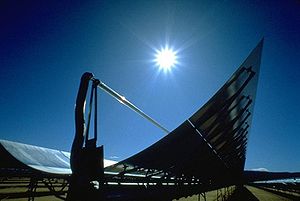
- Image via Wikipedia
For those of us in the Northern Hemisphere, spring has finally arrived. Spring is the time when many of us look to make changes to our homes. Whether it is a major “spring cleaningâ€, a kitchen remodel, or a landscape beautification project, spring seems to be the time when we are motivated to get things done. It is also the perfect time to take a look at the benefits of outdoor solar lights.
Assuming you spend at least some time working on the exterior of your home, adding some form of lighting to the area can really do wonders for the overall look of your yard or garden. Before outdoor solar lights became really popular, adding any type of conventional outdoor lighting was not only a hassle, but expensive as well. Conventional lighting also uses electricity which can have a major effect on our utility bills.
As we, as a society, have become more and more environmentally aware, solar power has grown more and more popular. Many families are converting their entire homes to solar power and seeing huge reductions in their energy bills. Converting an entire home can be a rather large project, however, and many of us are not quite ready for that major an undertaking. For those of us that fall under that category, replacing our front porch light with a solar security light or installing some solar garden lights to accent our home landscaping is an easy and inexpensive way to add beauty to our homes while still being environmentally responsible.
As solar technology continues to grow, an increasing number of manufacturers are using that technology to produce outdoor solar lighting fixtures in an ever expanding variety of styles that can be used for many different applications. Some of these include:
Motion sensing security lights
Pathway lighting
Accent lighting
Area flood lights
Spot lights
Christmas string lights
These are but a few uses. There are, of course, many more; and list continues to grow almost daily. Lately solar technology has been geared towards creating more efficient solar cells that are less expensive to build and do a better job of converting more of the suns light into usable energy. Companies are experimenting with technologies like solar inks and organic plastic polymers. These are just two of the possibilities that may soon make solar power more affordable than ever.
One final note that deserves mentioning about outdoor solar lights is that it is truly hard to find a home improvement project that is easier to complete. A solar garden lights project, for instance, can take anywhere from 15 minutes to an hour or so, depending upon how many lights you use. The method of installation is as simple as:
Remove the fixture from its packaging
Find a suitable location
Stick it in the ground
Turn it on
That’s basically it. The solar panel will collect energy during the day and store it in its built in battery. When it gets dark, the light will turn on automatically. It really doesn’t get much easier than that. Since most products have LED lights that are designed to last upwards of 100,000 hours, replacing burned out bulbs is unnecessary. The only maintenance that is ever needed is the occasional wiping off of the solar panel with a damp rag.
For more information about the uses and benefits of solar lights, please feel free to visit solarlightssite.com.

![Reblog this post [with Zemanta]](https://img.zemanta.com/reblog_e.png?x-id=9259f698-7b42-4f5e-a78d-bdb269e048d6)





As a lighting designer and a small business owner of
louielighting.com I wanted to comment on the importance of lighting quality as it relates to our children and adults. I believe we should strive for more efficient lighting solutions in schools but I do also have a concern that mandating changes too fast and the hype that surrounds this issue may result in the wrong implementation of lighting solutions and in sacrifices in light quality that I believe is so important to our well being. It takes time for new technologies to mature and to be fully understood by the professionals like lighting designers, electrical engineers, architects, interior designers and the public in general. It takes time to experience the new lighting solutions in order to implement them correctly into our schools, homes and other lighting projects.
Caution needs to be practiced in banning traditional light sources and time needs to be given for the industry to transition so that our future does not look like those futuristic movies that show cold dark streets and spaces with blue green fluorescent or neon lights.
Respectfully,
Arie Louie